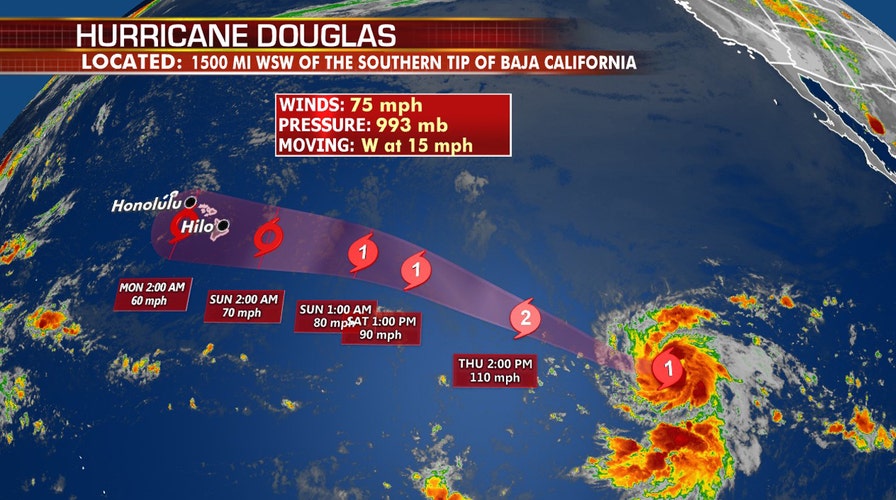National forecast for Wednesday, July 22
Fox News senior meteorologist Janice Dean has your FoxCast.
The fourth named storm of the Central Pacific hurricane season strengthened into a hurricane on Wednesday and may impact Hawaii by the weekend.
The U.S. National Hurricane Center (NHC) in Miami said that Hurricane Douglas is packing maximum sustained winds of 75 mph and is moving west at 14 mph.
The storm is about 1,785 miles east-southeast of Hilo, Hawaii, and is forecast to turn west-northwest and increase speed by late Wednesday.
ATLANTIC HURRICANE SEASON: WHERE DO TROPICAL STORMS FORM IN JULY?
The storm has been continuously strengthening as a tropical storm, with maximum sustained winds increasing Wednesday morning to 75 mph, with higher gusts.
"Additional strengthening is expected during the next day or two," the NHC said.

The forecast track of Hurricane Douglas. (Fox News)
Hurricane-force winds extend outward up to 15 miles from the center, while tropical-storm-force winds extend outward up to 80 miles.
There are no coastal watches or warnings in effect, but the forecast cone from the hurricane center shows the storm could approach the Hawaiian islands by the second half of this weekend.
"There is an increasing chance that strong winds and heavy rainfall could affect portions of the state beginning on Sunday," the NHC said Wednesday morning. "Interests on the Hawaiian Islands should continue to monitor the progress of Douglas."
If Douglas does impact Hawaii over the next few days, it would be a weaker system.
"Some weakening could begin on Friday once Douglas begins to move over cooler waters," the NHC said in a Wednesday morning update.
With a possible approaching storm during the coronavirus pandemic, Honolulu Mayor Kirk Caldwell on Tuesday urged residents on Oahu to have preparedness kits for two weeks, the Honolulu Star-Advertiser reported.
“We need to be ready,” Caldwell said. “We’re in hurricane season and if we have to evacuate, we need to find shelter space sufficient to handle folks who are going to move into shelters, hopefully, with their COVID-19 kits of hand sanitizers and face coverings and everything else.”
CORONAVIRUS AND HURRICANE SEASON: HERE'S WHY THE RED CROSS SAYS NOW IS THE TIME TO PREPARE
Emergency officials said they have spent the past few months restructuring plans due to the pandemic, but there's concern over proper staffing as volunteers tend to be retirees.

Hurricane Douglas can be seen swirling in the Pacific early July 22. (NOAA/GOES-East)
Screening procedures at shelters, which may include hotels, would be similar to those at airports. They would include temperature checks, and questions about symptoms and recent travel history, according to KHON2.
“We’re making sure that there’s classrooms available if someone is symptomatic that we can isolate them from the rest of the shelter, according to shelter screening procedures,” Jennifer Walter, deputy director of the Honolulu Department of Emergency Management, said Tuesday.
Those who live in homes that have hurricane clips will be asked to shelter in place and take care of others.
CLICK HERE FOR MORE WEATHER COVERAGE FROM FOX NEWS
“Make it available to your family members that can shelter in place with you because the more we can do ahead of time to people’s plans to stay at shelters, the less impact we’re gonna have in trying to scramble and open sites,” Walter added.
Federal forecasters said in May that the Central Pacific basin, including Hawaii, should expect to see between two and six tropical storms or hurricanes this year.
Last year, four tropical cyclones developed in the Central Pacific. None directly impacted Hawaii.
In 2018, the massive and powerful Hurricane Lane made a last-minute turn and narrowly spared Oahu, Hawaii's most populous island. The last major hurricane to strike the state was Hurricane Iniki in 1992, which hit Kauai and caused massive damage across the island.
CLICK HERE FOR THE FOX NEWS APP
Hurricane season in Hawaii lasts from June 1 until the end of November. August and September are historically active months for cyclones in the region.
The storm in the Pacific comes as Tropical Storm Gonzalo formed in the Atlantic and is forecast to become a hurricane by Thursday.
Fox News' Janice Dean, Brandon Noriega, and The Associated Press contributed to this report.



